Comparative Analysis of Retail Management in Australia and India
VerifiedAdded on 2022/10/19
|13
|3700
|61
Report
AI Summary
This report provides a comparative analysis of the retail industries in Australia and India. It begins with an executive summary and an introduction to retailing systems in both countries, followed by an examination of the differences in their retail market structures. The report assesses the potential size and profitability of the retail industry in each nation, analyzes the problems faced by retailers in both countries, and considers the cultural aspects impacting retailing. The Australian retail market, characterized by supermarkets, specialty stores, and online retailing, is contrasted with India's diverse retail landscape, including departmental stores and convenience stores. The report highlights key challenges such as technological advancements, convenient delivery, and data utilization in Australia, while in India, it addresses technology adoption, price wars, cultural diversity, and complex tax structures. The report concludes with recommendations for both countries, emphasizing the importance of adapting to evolving customer preferences, technological advancements, and cultural nuances to achieve better results.

Retail management
Paraphrase This Document
Need a fresh take? Get an instant paraphrase of this document with our AI Paraphraser
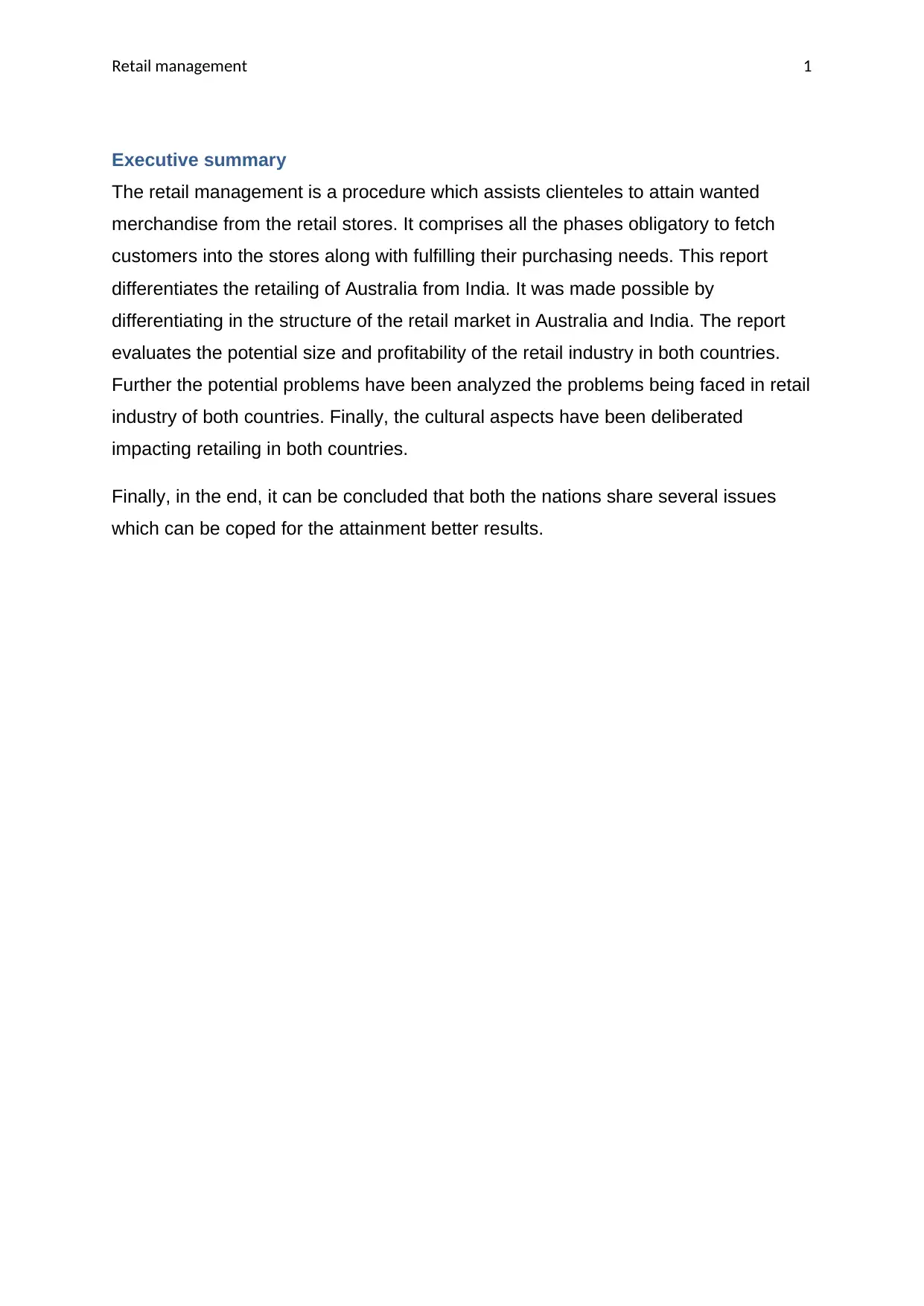
Retail management 1
Executive summary
The retail management is a procedure which assists clienteles to attain wanted
merchandise from the retail stores. It comprises all the phases obligatory to fetch
customers into the stores along with fulfilling their purchasing needs. This report
differentiates the retailing of Australia from India. It was made possible by
differentiating in the structure of the retail market in Australia and India. The report
evaluates the potential size and profitability of the retail industry in both countries.
Further the potential problems have been analyzed the problems being faced in retail
industry of both countries. Finally, the cultural aspects have been deliberated
impacting retailing in both countries.
Finally, in the end, it can be concluded that both the nations share several issues
which can be coped for the attainment better results.
Executive summary
The retail management is a procedure which assists clienteles to attain wanted
merchandise from the retail stores. It comprises all the phases obligatory to fetch
customers into the stores along with fulfilling their purchasing needs. This report
differentiates the retailing of Australia from India. It was made possible by
differentiating in the structure of the retail market in Australia and India. The report
evaluates the potential size and profitability of the retail industry in both countries.
Further the potential problems have been analyzed the problems being faced in retail
industry of both countries. Finally, the cultural aspects have been deliberated
impacting retailing in both countries.
Finally, in the end, it can be concluded that both the nations share several issues
which can be coped for the attainment better results.
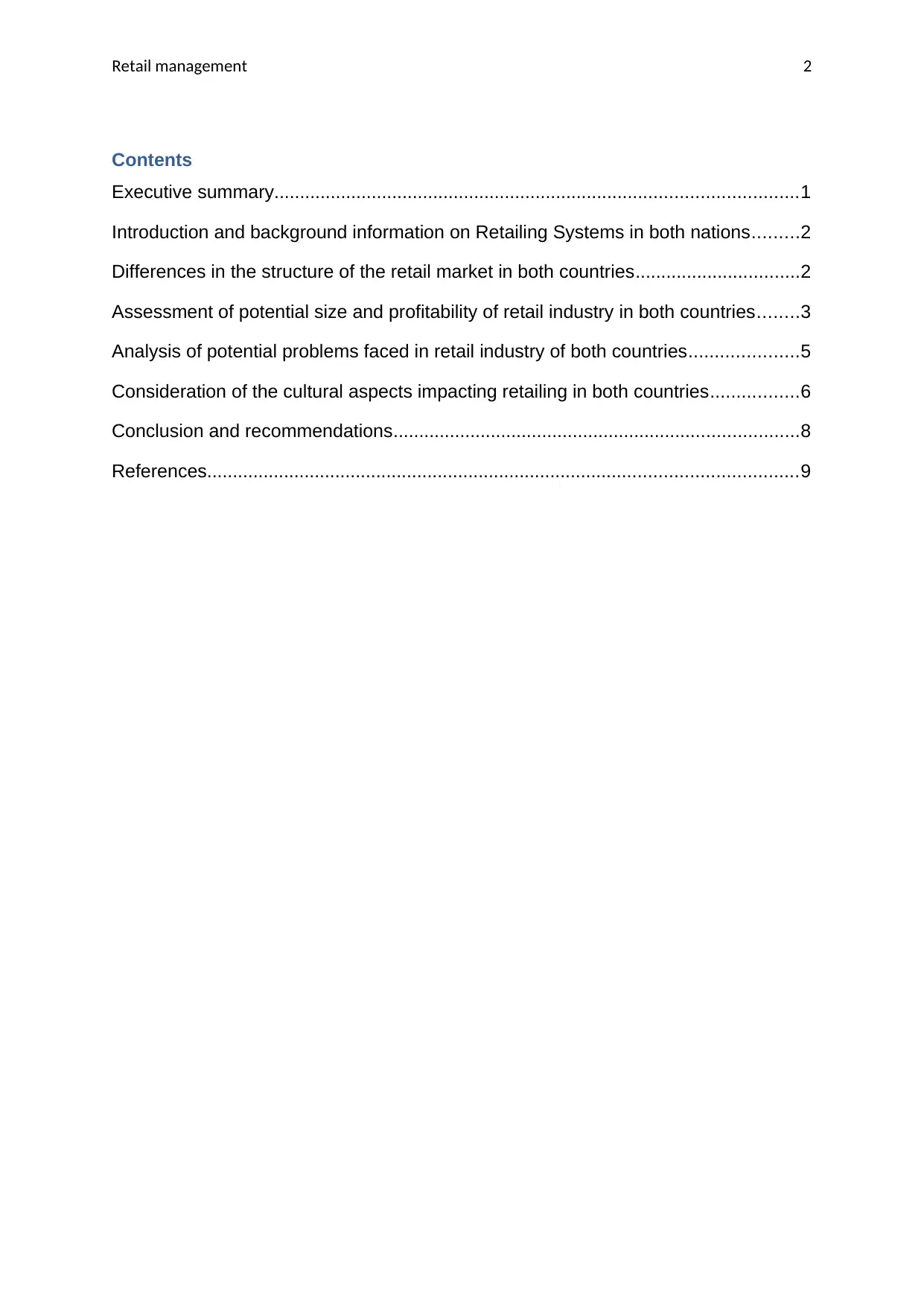
Retail management 2
Contents
Executive summary......................................................................................................1
Introduction and background information on Retailing Systems in both nations.........2
Differences in the structure of the retail market in both countries................................2
Assessment of potential size and profitability of retail industry in both countries........3
Analysis of potential problems faced in retail industry of both countries.....................5
Consideration of the cultural aspects impacting retailing in both countries.................6
Conclusion and recommendations...............................................................................8
References...................................................................................................................9
Contents
Executive summary......................................................................................................1
Introduction and background information on Retailing Systems in both nations.........2
Differences in the structure of the retail market in both countries................................2
Assessment of potential size and profitability of retail industry in both countries........3
Analysis of potential problems faced in retail industry of both countries.....................5
Consideration of the cultural aspects impacting retailing in both countries.................6
Conclusion and recommendations...............................................................................8
References...................................................................................................................9
⊘ This is a preview!⊘
Do you want full access?
Subscribe today to unlock all pages.

Trusted by 1+ million students worldwide
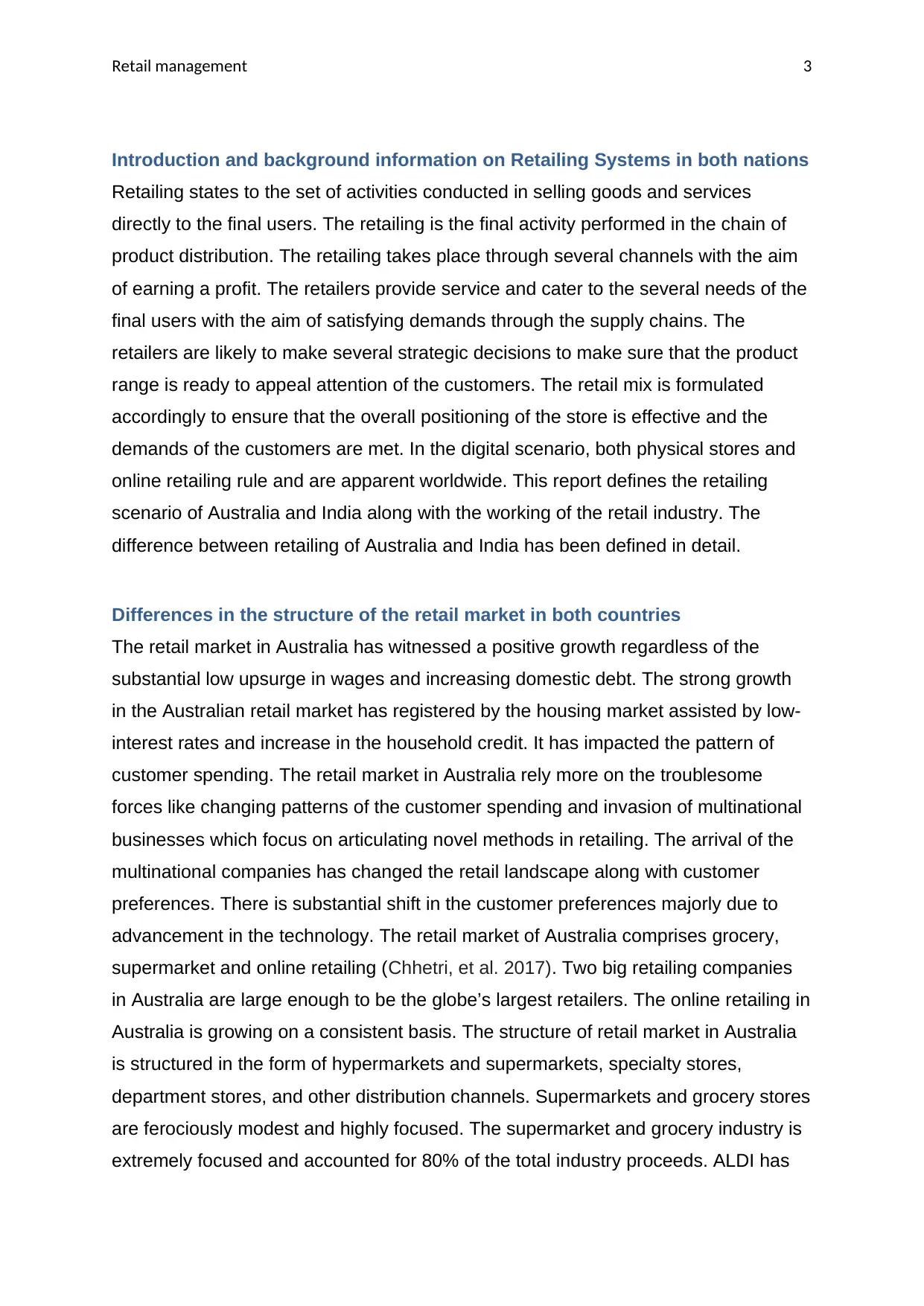
Retail management 3
Introduction and background information on Retailing Systems in both nations
Retailing states to the set of activities conducted in selling goods and services
directly to the final users. The retailing is the final activity performed in the chain of
product distribution. The retailing takes place through several channels with the aim
of earning a profit. The retailers provide service and cater to the several needs of the
final users with the aim of satisfying demands through the supply chains. The
retailers are likely to make several strategic decisions to make sure that the product
range is ready to appeal attention of the customers. The retail mix is formulated
accordingly to ensure that the overall positioning of the store is effective and the
demands of the customers are met. In the digital scenario, both physical stores and
online retailing rule and are apparent worldwide. This report defines the retailing
scenario of Australia and India along with the working of the retail industry. The
difference between retailing of Australia and India has been defined in detail.
Differences in the structure of the retail market in both countries
The retail market in Australia has witnessed a positive growth regardless of the
substantial low upsurge in wages and increasing domestic debt. The strong growth
in the Australian retail market has registered by the housing market assisted by low-
interest rates and increase in the household credit. It has impacted the pattern of
customer spending. The retail market in Australia rely more on the troublesome
forces like changing patterns of the customer spending and invasion of multinational
businesses which focus on articulating novel methods in retailing. The arrival of the
multinational companies has changed the retail landscape along with customer
preferences. There is substantial shift in the customer preferences majorly due to
advancement in the technology. The retail market of Australia comprises grocery,
supermarket and online retailing (Chhetri, et al. 2017). Two big retailing companies
in Australia are large enough to be the globe’s largest retailers. The online retailing in
Australia is growing on a consistent basis. The structure of retail market in Australia
is structured in the form of hypermarkets and supermarkets, specialty stores,
department stores, and other distribution channels. Supermarkets and grocery stores
are ferociously modest and highly focused. The supermarket and grocery industry is
extremely focused and accounted for 80% of the total industry proceeds. ALDI has
Introduction and background information on Retailing Systems in both nations
Retailing states to the set of activities conducted in selling goods and services
directly to the final users. The retailing is the final activity performed in the chain of
product distribution. The retailing takes place through several channels with the aim
of earning a profit. The retailers provide service and cater to the several needs of the
final users with the aim of satisfying demands through the supply chains. The
retailers are likely to make several strategic decisions to make sure that the product
range is ready to appeal attention of the customers. The retail mix is formulated
accordingly to ensure that the overall positioning of the store is effective and the
demands of the customers are met. In the digital scenario, both physical stores and
online retailing rule and are apparent worldwide. This report defines the retailing
scenario of Australia and India along with the working of the retail industry. The
difference between retailing of Australia and India has been defined in detail.
Differences in the structure of the retail market in both countries
The retail market in Australia has witnessed a positive growth regardless of the
substantial low upsurge in wages and increasing domestic debt. The strong growth
in the Australian retail market has registered by the housing market assisted by low-
interest rates and increase in the household credit. It has impacted the pattern of
customer spending. The retail market in Australia rely more on the troublesome
forces like changing patterns of the customer spending and invasion of multinational
businesses which focus on articulating novel methods in retailing. The arrival of the
multinational companies has changed the retail landscape along with customer
preferences. There is substantial shift in the customer preferences majorly due to
advancement in the technology. The retail market of Australia comprises grocery,
supermarket and online retailing (Chhetri, et al. 2017). Two big retailing companies
in Australia are large enough to be the globe’s largest retailers. The online retailing in
Australia is growing on a consistent basis. The structure of retail market in Australia
is structured in the form of hypermarkets and supermarkets, specialty stores,
department stores, and other distribution channels. Supermarkets and grocery stores
are ferociously modest and highly focused. The supermarket and grocery industry is
extremely focused and accounted for 80% of the total industry proceeds. ALDI has
Paraphrase This Document
Need a fresh take? Get an instant paraphrase of this document with our AI Paraphraser
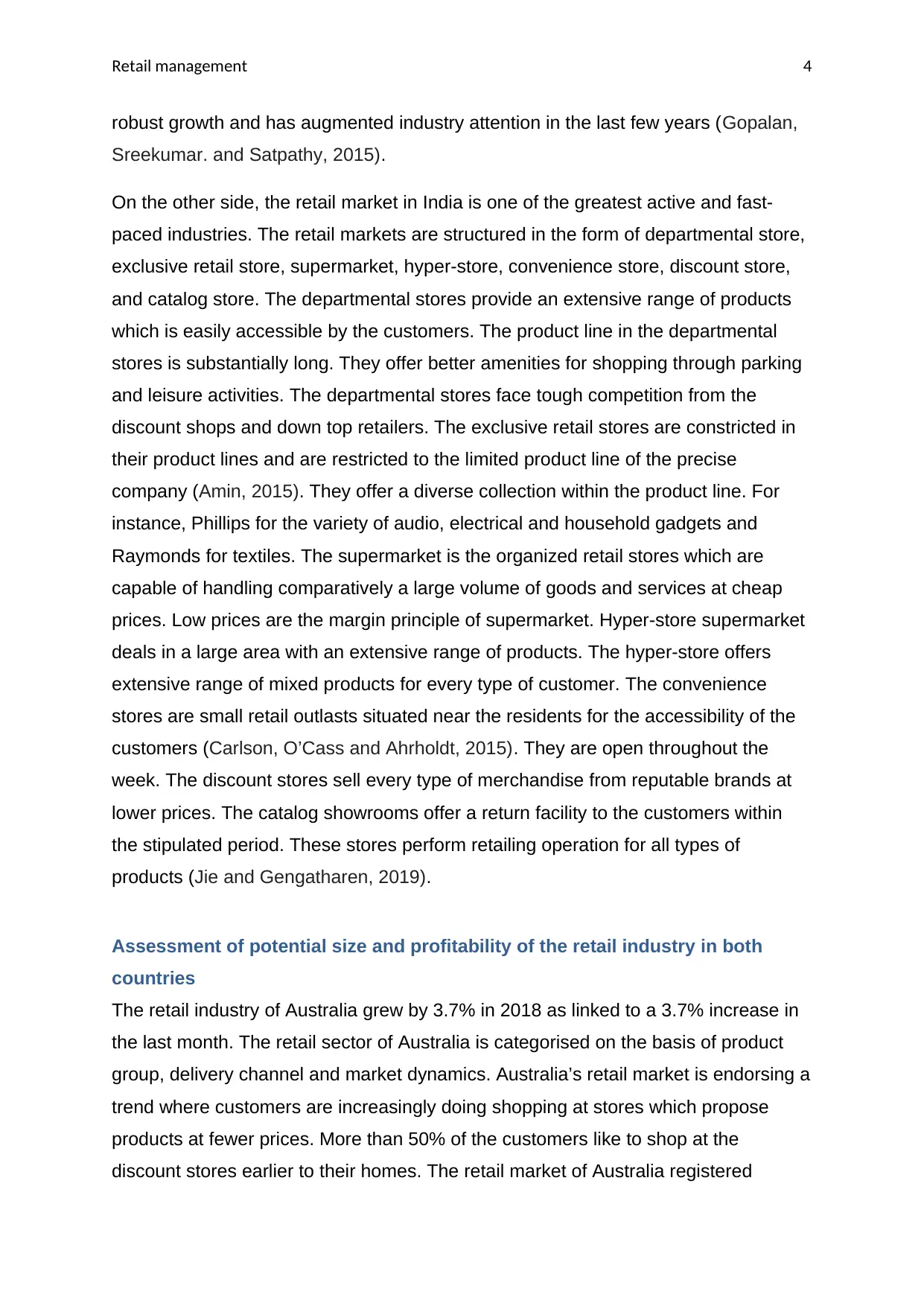
Retail management 4
robust growth and has augmented industry attention in the last few years (Gopalan,
Sreekumar. and Satpathy, 2015).
On the other side, the retail market in India is one of the greatest active and fast-
paced industries. The retail markets are structured in the form of departmental store,
exclusive retail store, supermarket, hyper-store, convenience store, discount store,
and catalog store. The departmental stores provide an extensive range of products
which is easily accessible by the customers. The product line in the departmental
stores is substantially long. They offer better amenities for shopping through parking
and leisure activities. The departmental stores face tough competition from the
discount shops and down top retailers. The exclusive retail stores are constricted in
their product lines and are restricted to the limited product line of the precise
company (Amin, 2015). They offer a diverse collection within the product line. For
instance, Phillips for the variety of audio, electrical and household gadgets and
Raymonds for textiles. The supermarket is the organized retail stores which are
capable of handling comparatively a large volume of goods and services at cheap
prices. Low prices are the margin principle of supermarket. Hyper-store supermarket
deals in a large area with an extensive range of products. The hyper-store offers
extensive range of mixed products for every type of customer. The convenience
stores are small retail outlasts situated near the residents for the accessibility of the
customers (Carlson, O’Cass and Ahrholdt, 2015). They are open throughout the
week. The discount stores sell every type of merchandise from reputable brands at
lower prices. The catalog showrooms offer a return facility to the customers within
the stipulated period. These stores perform retailing operation for all types of
products (Jie and Gengatharen, 2019).
Assessment of potential size and profitability of the retail industry in both
countries
The retail industry of Australia grew by 3.7% in 2018 as linked to a 3.7% increase in
the last month. The retail sector of Australia is categorised on the basis of product
group, delivery channel and market dynamics. Australia’s retail market is endorsing a
trend where customers are increasingly doing shopping at stores which propose
products at fewer prices. More than 50% of the customers like to shop at the
discount stores earlier to their homes. The retail market of Australia registered
robust growth and has augmented industry attention in the last few years (Gopalan,
Sreekumar. and Satpathy, 2015).
On the other side, the retail market in India is one of the greatest active and fast-
paced industries. The retail markets are structured in the form of departmental store,
exclusive retail store, supermarket, hyper-store, convenience store, discount store,
and catalog store. The departmental stores provide an extensive range of products
which is easily accessible by the customers. The product line in the departmental
stores is substantially long. They offer better amenities for shopping through parking
and leisure activities. The departmental stores face tough competition from the
discount shops and down top retailers. The exclusive retail stores are constricted in
their product lines and are restricted to the limited product line of the precise
company (Amin, 2015). They offer a diverse collection within the product line. For
instance, Phillips for the variety of audio, electrical and household gadgets and
Raymonds for textiles. The supermarket is the organized retail stores which are
capable of handling comparatively a large volume of goods and services at cheap
prices. Low prices are the margin principle of supermarket. Hyper-store supermarket
deals in a large area with an extensive range of products. The hyper-store offers
extensive range of mixed products for every type of customer. The convenience
stores are small retail outlasts situated near the residents for the accessibility of the
customers (Carlson, O’Cass and Ahrholdt, 2015). They are open throughout the
week. The discount stores sell every type of merchandise from reputable brands at
lower prices. The catalog showrooms offer a return facility to the customers within
the stipulated period. These stores perform retailing operation for all types of
products (Jie and Gengatharen, 2019).
Assessment of potential size and profitability of the retail industry in both
countries
The retail industry of Australia grew by 3.7% in 2018 as linked to a 3.7% increase in
the last month. The retail sector of Australia is categorised on the basis of product
group, delivery channel and market dynamics. Australia’s retail market is endorsing a
trend where customers are increasingly doing shopping at stores which propose
products at fewer prices. More than 50% of the customers like to shop at the
discount stores earlier to their homes. The retail market of Australia registered
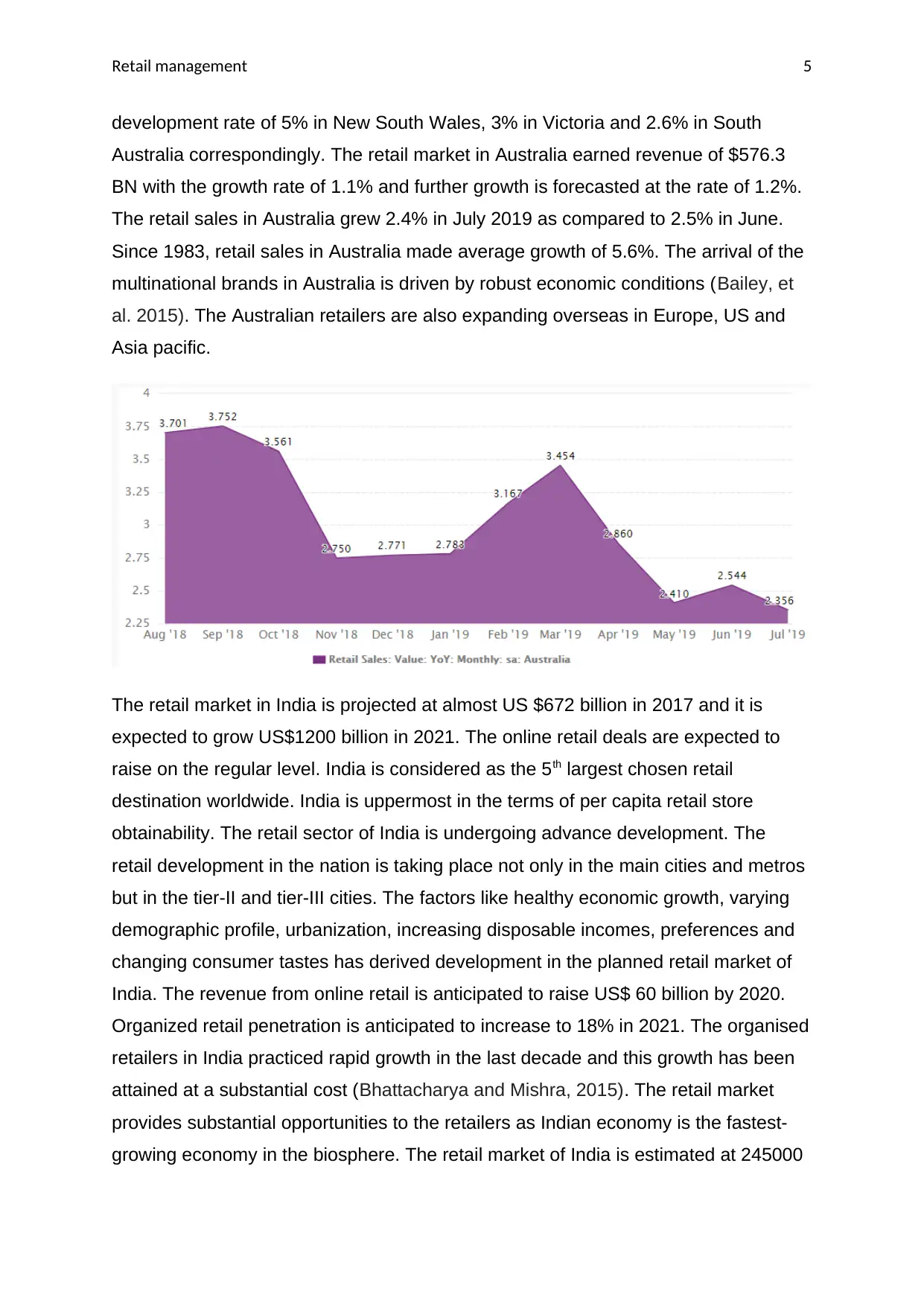
Retail management 5
development rate of 5% in New South Wales, 3% in Victoria and 2.6% in South
Australia correspondingly. The retail market in Australia earned revenue of $576.3
BN with the growth rate of 1.1% and further growth is forecasted at the rate of 1.2%.
The retail sales in Australia grew 2.4% in July 2019 as compared to 2.5% in June.
Since 1983, retail sales in Australia made average growth of 5.6%. The arrival of the
multinational brands in Australia is driven by robust economic conditions (Bailey, et
al. 2015). The Australian retailers are also expanding overseas in Europe, US and
Asia pacific.
The retail market in India is projected at almost US $672 billion in 2017 and it is
expected to grow US$1200 billion in 2021. The online retail deals are expected to
raise on the regular level. India is considered as the 5th largest chosen retail
destination worldwide. India is uppermost in the terms of per capita retail store
obtainability. The retail sector of India is undergoing advance development. The
retail development in the nation is taking place not only in the main cities and metros
but in the tier-II and tier-III cities. The factors like healthy economic growth, varying
demographic profile, urbanization, increasing disposable incomes, preferences and
changing consumer tastes has derived development in the planned retail market of
India. The revenue from online retail is anticipated to raise US$ 60 billion by 2020.
Organized retail penetration is anticipated to increase to 18% in 2021. The organised
retailers in India practiced rapid growth in the last decade and this growth has been
attained at a substantial cost (Bhattacharya and Mishra, 2015). The retail market
provides substantial opportunities to the retailers as Indian economy is the fastest-
growing economy in the biosphere. The retail market of India is estimated at 245000
development rate of 5% in New South Wales, 3% in Victoria and 2.6% in South
Australia correspondingly. The retail market in Australia earned revenue of $576.3
BN with the growth rate of 1.1% and further growth is forecasted at the rate of 1.2%.
The retail sales in Australia grew 2.4% in July 2019 as compared to 2.5% in June.
Since 1983, retail sales in Australia made average growth of 5.6%. The arrival of the
multinational brands in Australia is driven by robust economic conditions (Bailey, et
al. 2015). The Australian retailers are also expanding overseas in Europe, US and
Asia pacific.
The retail market in India is projected at almost US $672 billion in 2017 and it is
expected to grow US$1200 billion in 2021. The online retail deals are expected to
raise on the regular level. India is considered as the 5th largest chosen retail
destination worldwide. India is uppermost in the terms of per capita retail store
obtainability. The retail sector of India is undergoing advance development. The
retail development in the nation is taking place not only in the main cities and metros
but in the tier-II and tier-III cities. The factors like healthy economic growth, varying
demographic profile, urbanization, increasing disposable incomes, preferences and
changing consumer tastes has derived development in the planned retail market of
India. The revenue from online retail is anticipated to raise US$ 60 billion by 2020.
Organized retail penetration is anticipated to increase to 18% in 2021. The organised
retailers in India practiced rapid growth in the last decade and this growth has been
attained at a substantial cost (Bhattacharya and Mishra, 2015). The retail market
provides substantial opportunities to the retailers as Indian economy is the fastest-
growing economy in the biosphere. The retail market of India is estimated at 245000
⊘ This is a preview!⊘
Do you want full access?
Subscribe today to unlock all pages.

Trusted by 1+ million students worldwide
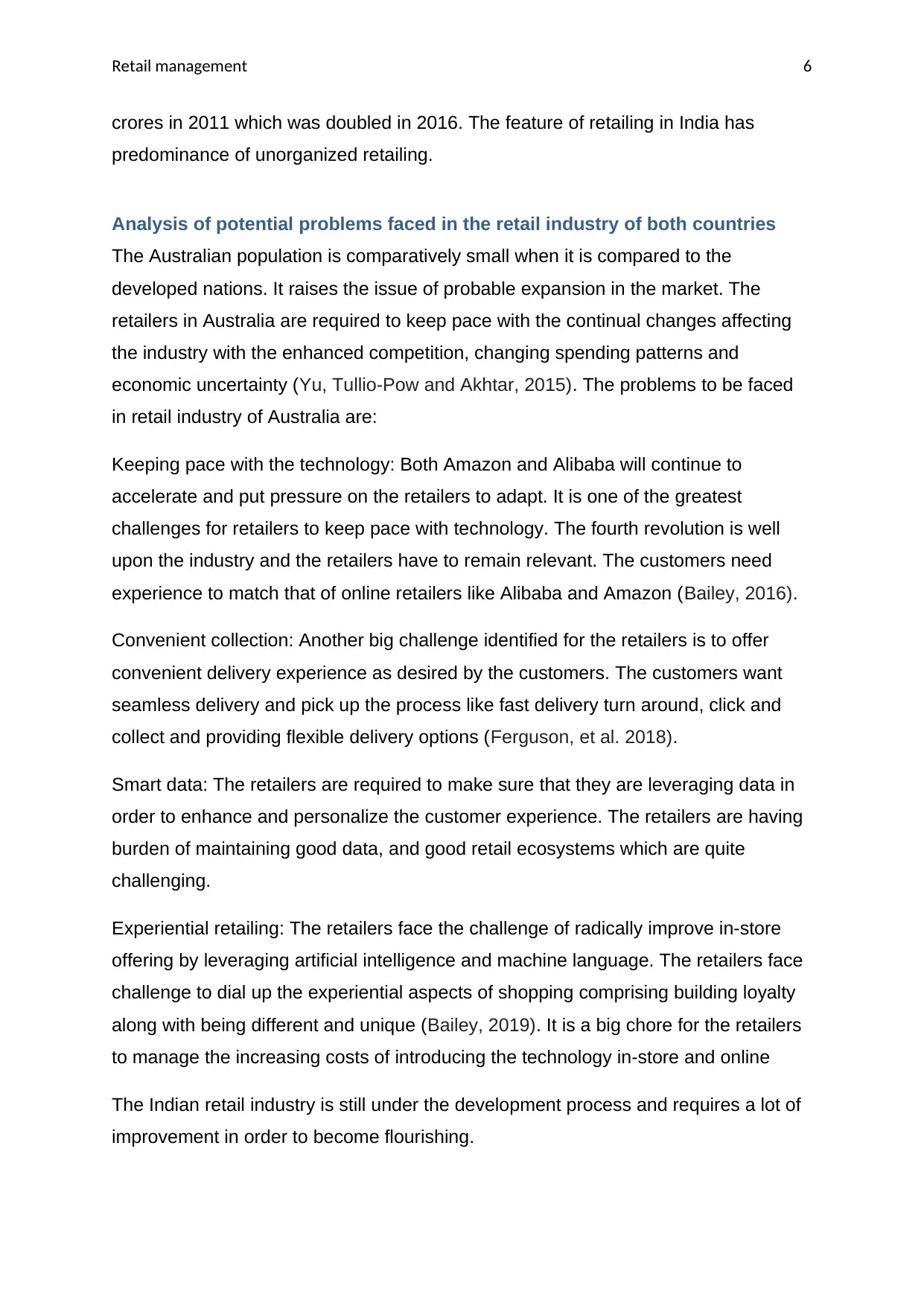
Retail management 6
crores in 2011 which was doubled in 2016. The feature of retailing in India has
predominance of unorganized retailing.
Analysis of potential problems faced in the retail industry of both countries
The Australian population is comparatively small when it is compared to the
developed nations. It raises the issue of probable expansion in the market. The
retailers in Australia are required to keep pace with the continual changes affecting
the industry with the enhanced competition, changing spending patterns and
economic uncertainty (Yu, Tullio-Pow and Akhtar, 2015). The problems to be faced
in retail industry of Australia are:
Keeping pace with the technology: Both Amazon and Alibaba will continue to
accelerate and put pressure on the retailers to adapt. It is one of the greatest
challenges for retailers to keep pace with technology. The fourth revolution is well
upon the industry and the retailers have to remain relevant. The customers need
experience to match that of online retailers like Alibaba and Amazon (Bailey, 2016).
Convenient collection: Another big challenge identified for the retailers is to offer
convenient delivery experience as desired by the customers. The customers want
seamless delivery and pick up the process like fast delivery turn around, click and
collect and providing flexible delivery options (Ferguson, et al. 2018).
Smart data: The retailers are required to make sure that they are leveraging data in
order to enhance and personalize the customer experience. The retailers are having
burden of maintaining good data, and good retail ecosystems which are quite
challenging.
Experiential retailing: The retailers face the challenge of radically improve in-store
offering by leveraging artificial intelligence and machine language. The retailers face
challenge to dial up the experiential aspects of shopping comprising building loyalty
along with being different and unique (Bailey, 2019). It is a big chore for the retailers
to manage the increasing costs of introducing the technology in-store and online
The Indian retail industry is still under the development process and requires a lot of
improvement in order to become flourishing.
crores in 2011 which was doubled in 2016. The feature of retailing in India has
predominance of unorganized retailing.
Analysis of potential problems faced in the retail industry of both countries
The Australian population is comparatively small when it is compared to the
developed nations. It raises the issue of probable expansion in the market. The
retailers in Australia are required to keep pace with the continual changes affecting
the industry with the enhanced competition, changing spending patterns and
economic uncertainty (Yu, Tullio-Pow and Akhtar, 2015). The problems to be faced
in retail industry of Australia are:
Keeping pace with the technology: Both Amazon and Alibaba will continue to
accelerate and put pressure on the retailers to adapt. It is one of the greatest
challenges for retailers to keep pace with technology. The fourth revolution is well
upon the industry and the retailers have to remain relevant. The customers need
experience to match that of online retailers like Alibaba and Amazon (Bailey, 2016).
Convenient collection: Another big challenge identified for the retailers is to offer
convenient delivery experience as desired by the customers. The customers want
seamless delivery and pick up the process like fast delivery turn around, click and
collect and providing flexible delivery options (Ferguson, et al. 2018).
Smart data: The retailers are required to make sure that they are leveraging data in
order to enhance and personalize the customer experience. The retailers are having
burden of maintaining good data, and good retail ecosystems which are quite
challenging.
Experiential retailing: The retailers face the challenge of radically improve in-store
offering by leveraging artificial intelligence and machine language. The retailers face
challenge to dial up the experiential aspects of shopping comprising building loyalty
along with being different and unique (Bailey, 2019). It is a big chore for the retailers
to manage the increasing costs of introducing the technology in-store and online
The Indian retail industry is still under the development process and requires a lot of
improvement in order to become flourishing.
Paraphrase This Document
Need a fresh take? Get an instant paraphrase of this document with our AI Paraphraser
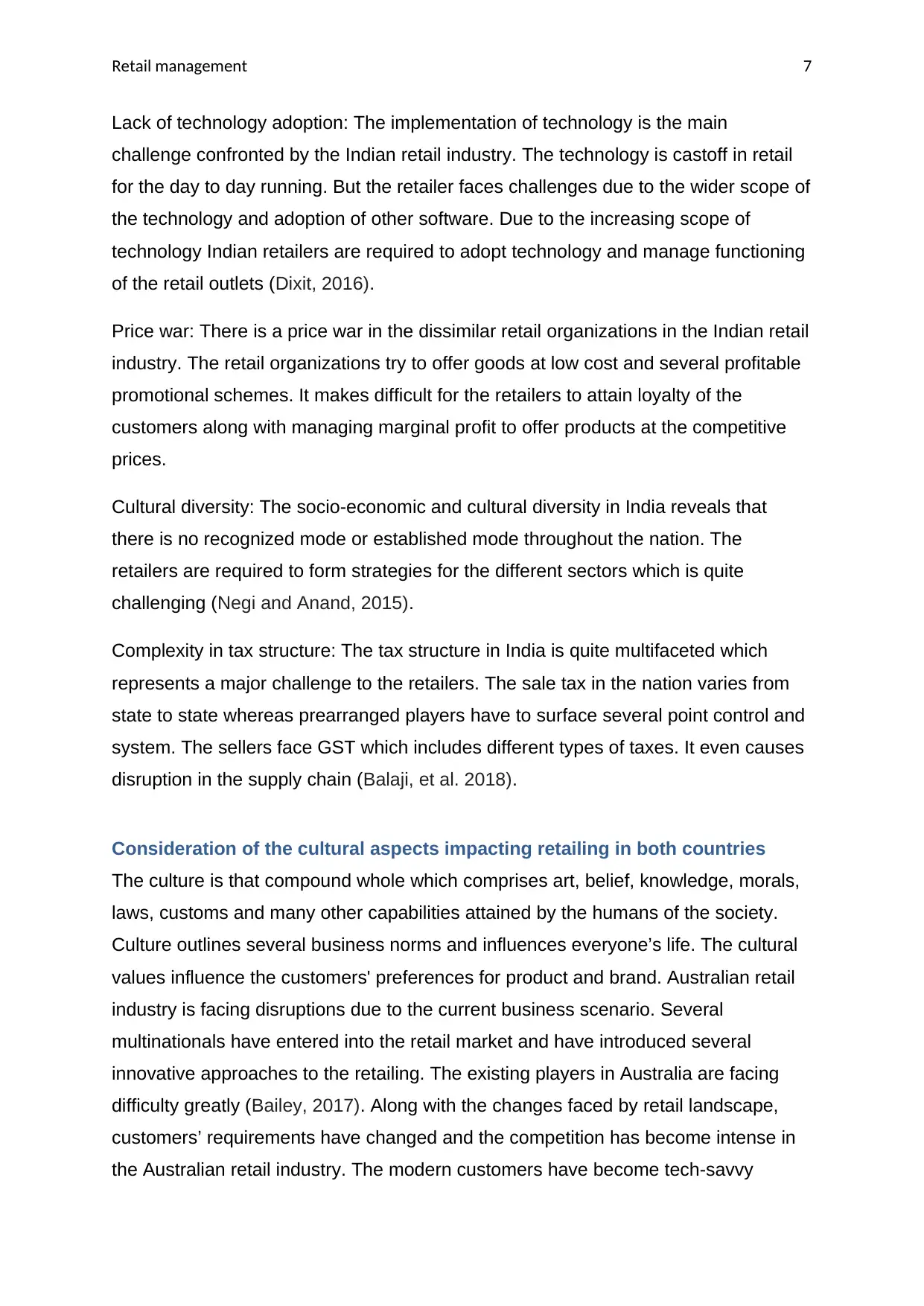
Retail management 7
Lack of technology adoption: The implementation of technology is the main
challenge confronted by the Indian retail industry. The technology is castoff in retail
for the day to day running. But the retailer faces challenges due to the wider scope of
the technology and adoption of other software. Due to the increasing scope of
technology Indian retailers are required to adopt technology and manage functioning
of the retail outlets (Dixit, 2016).
Price war: There is a price war in the dissimilar retail organizations in the Indian retail
industry. The retail organizations try to offer goods at low cost and several profitable
promotional schemes. It makes difficult for the retailers to attain loyalty of the
customers along with managing marginal profit to offer products at the competitive
prices.
Cultural diversity: The socio-economic and cultural diversity in India reveals that
there is no recognized mode or established mode throughout the nation. The
retailers are required to form strategies for the different sectors which is quite
challenging (Negi and Anand, 2015).
Complexity in tax structure: The tax structure in India is quite multifaceted which
represents a major challenge to the retailers. The sale tax in the nation varies from
state to state whereas prearranged players have to surface several point control and
system. The sellers face GST which includes different types of taxes. It even causes
disruption in the supply chain (Balaji, et al. 2018).
Consideration of the cultural aspects impacting retailing in both countries
The culture is that compound whole which comprises art, belief, knowledge, morals,
laws, customs and many other capabilities attained by the humans of the society.
Culture outlines several business norms and influences everyone’s life. The cultural
values influence the customers' preferences for product and brand. Australian retail
industry is facing disruptions due to the current business scenario. Several
multinationals have entered into the retail market and have introduced several
innovative approaches to the retailing. The existing players in Australia are facing
difficulty greatly (Bailey, 2017). Along with the changes faced by retail landscape,
customers’ requirements have changed and the competition has become intense in
the Australian retail industry. The modern customers have become tech-savvy
Lack of technology adoption: The implementation of technology is the main
challenge confronted by the Indian retail industry. The technology is castoff in retail
for the day to day running. But the retailer faces challenges due to the wider scope of
the technology and adoption of other software. Due to the increasing scope of
technology Indian retailers are required to adopt technology and manage functioning
of the retail outlets (Dixit, 2016).
Price war: There is a price war in the dissimilar retail organizations in the Indian retail
industry. The retail organizations try to offer goods at low cost and several profitable
promotional schemes. It makes difficult for the retailers to attain loyalty of the
customers along with managing marginal profit to offer products at the competitive
prices.
Cultural diversity: The socio-economic and cultural diversity in India reveals that
there is no recognized mode or established mode throughout the nation. The
retailers are required to form strategies for the different sectors which is quite
challenging (Negi and Anand, 2015).
Complexity in tax structure: The tax structure in India is quite multifaceted which
represents a major challenge to the retailers. The sale tax in the nation varies from
state to state whereas prearranged players have to surface several point control and
system. The sellers face GST which includes different types of taxes. It even causes
disruption in the supply chain (Balaji, et al. 2018).
Consideration of the cultural aspects impacting retailing in both countries
The culture is that compound whole which comprises art, belief, knowledge, morals,
laws, customs and many other capabilities attained by the humans of the society.
Culture outlines several business norms and influences everyone’s life. The cultural
values influence the customers' preferences for product and brand. Australian retail
industry is facing disruptions due to the current business scenario. Several
multinationals have entered into the retail market and have introduced several
innovative approaches to the retailing. The existing players in Australia are facing
difficulty greatly (Bailey, 2017). Along with the changes faced by retail landscape,
customers’ requirements have changed and the competition has become intense in
the Australian retail industry. The modern customers have become tech-savvy
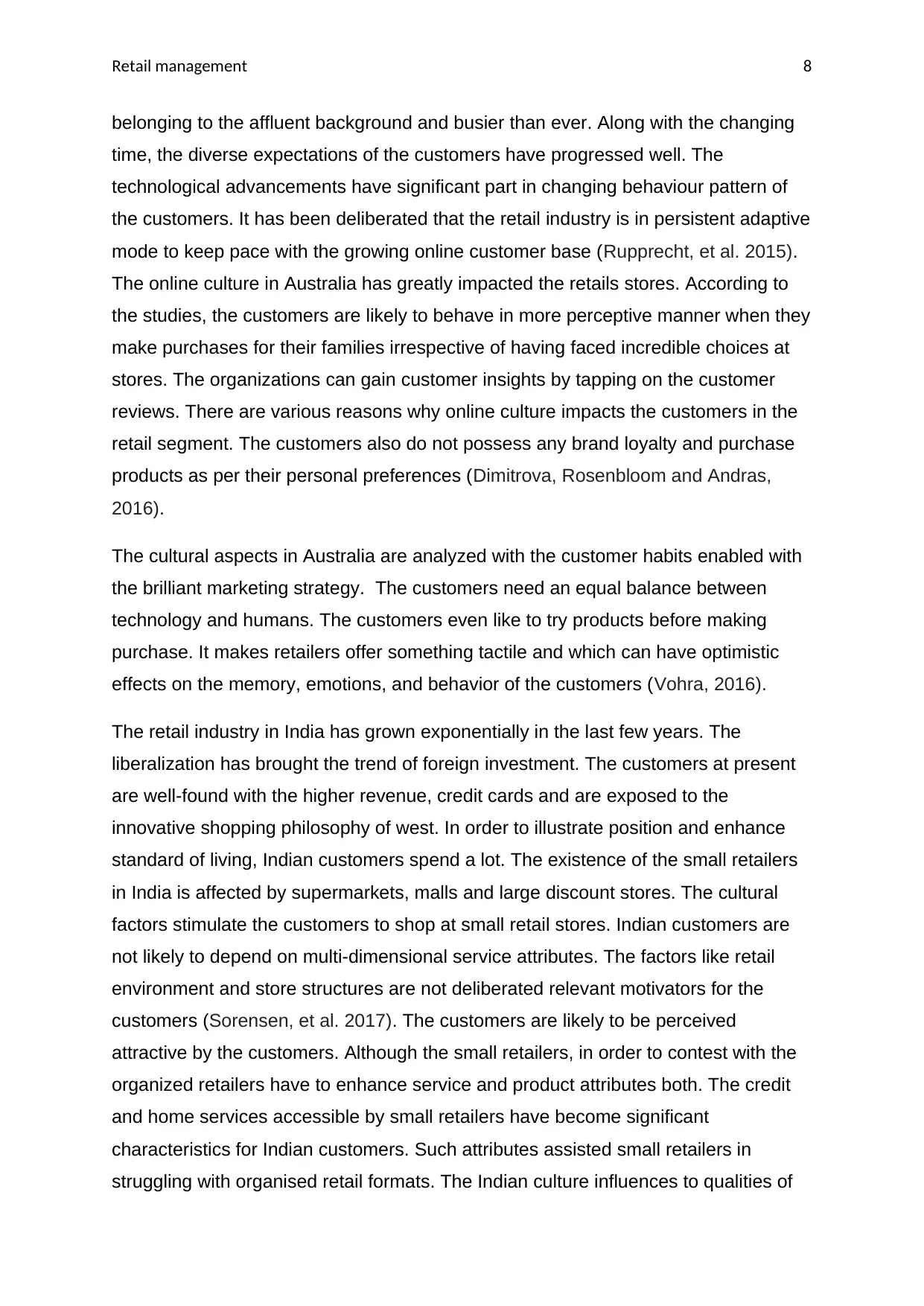
Retail management 8
belonging to the affluent background and busier than ever. Along with the changing
time, the diverse expectations of the customers have progressed well. The
technological advancements have significant part in changing behaviour pattern of
the customers. It has been deliberated that the retail industry is in persistent adaptive
mode to keep pace with the growing online customer base (Rupprecht, et al. 2015).
The online culture in Australia has greatly impacted the retails stores. According to
the studies, the customers are likely to behave in more perceptive manner when they
make purchases for their families irrespective of having faced incredible choices at
stores. The organizations can gain customer insights by tapping on the customer
reviews. There are various reasons why online culture impacts the customers in the
retail segment. The customers also do not possess any brand loyalty and purchase
products as per their personal preferences (Dimitrova, Rosenbloom and Andras,
2016).
The cultural aspects in Australia are analyzed with the customer habits enabled with
the brilliant marketing strategy. The customers need an equal balance between
technology and humans. The customers even like to try products before making
purchase. It makes retailers offer something tactile and which can have optimistic
effects on the memory, emotions, and behavior of the customers (Vohra, 2016).
The retail industry in India has grown exponentially in the last few years. The
liberalization has brought the trend of foreign investment. The customers at present
are well-found with the higher revenue, credit cards and are exposed to the
innovative shopping philosophy of west. In order to illustrate position and enhance
standard of living, Indian customers spend a lot. The existence of the small retailers
in India is affected by supermarkets, malls and large discount stores. The cultural
factors stimulate the customers to shop at small retail stores. Indian customers are
not likely to depend on multi-dimensional service attributes. The factors like retail
environment and store structures are not deliberated relevant motivators for the
customers (Sorensen, et al. 2017). The customers are likely to be perceived
attractive by the customers. Although the small retailers, in order to contest with the
organized retailers have to enhance service and product attributes both. The credit
and home services accessible by small retailers have become significant
characteristics for Indian customers. Such attributes assisted small retailers in
struggling with organised retail formats. The Indian culture influences to qualities of
belonging to the affluent background and busier than ever. Along with the changing
time, the diverse expectations of the customers have progressed well. The
technological advancements have significant part in changing behaviour pattern of
the customers. It has been deliberated that the retail industry is in persistent adaptive
mode to keep pace with the growing online customer base (Rupprecht, et al. 2015).
The online culture in Australia has greatly impacted the retails stores. According to
the studies, the customers are likely to behave in more perceptive manner when they
make purchases for their families irrespective of having faced incredible choices at
stores. The organizations can gain customer insights by tapping on the customer
reviews. There are various reasons why online culture impacts the customers in the
retail segment. The customers also do not possess any brand loyalty and purchase
products as per their personal preferences (Dimitrova, Rosenbloom and Andras,
2016).
The cultural aspects in Australia are analyzed with the customer habits enabled with
the brilliant marketing strategy. The customers need an equal balance between
technology and humans. The customers even like to try products before making
purchase. It makes retailers offer something tactile and which can have optimistic
effects on the memory, emotions, and behavior of the customers (Vohra, 2016).
The retail industry in India has grown exponentially in the last few years. The
liberalization has brought the trend of foreign investment. The customers at present
are well-found with the higher revenue, credit cards and are exposed to the
innovative shopping philosophy of west. In order to illustrate position and enhance
standard of living, Indian customers spend a lot. The existence of the small retailers
in India is affected by supermarkets, malls and large discount stores. The cultural
factors stimulate the customers to shop at small retail stores. Indian customers are
not likely to depend on multi-dimensional service attributes. The factors like retail
environment and store structures are not deliberated relevant motivators for the
customers (Sorensen, et al. 2017). The customers are likely to be perceived
attractive by the customers. Although the small retailers, in order to contest with the
organized retailers have to enhance service and product attributes both. The credit
and home services accessible by small retailers have become significant
characteristics for Indian customers. Such attributes assisted small retailers in
struggling with organised retail formats. The Indian culture influences to qualities of
⊘ This is a preview!⊘
Do you want full access?
Subscribe today to unlock all pages.

Trusted by 1+ million students worldwide
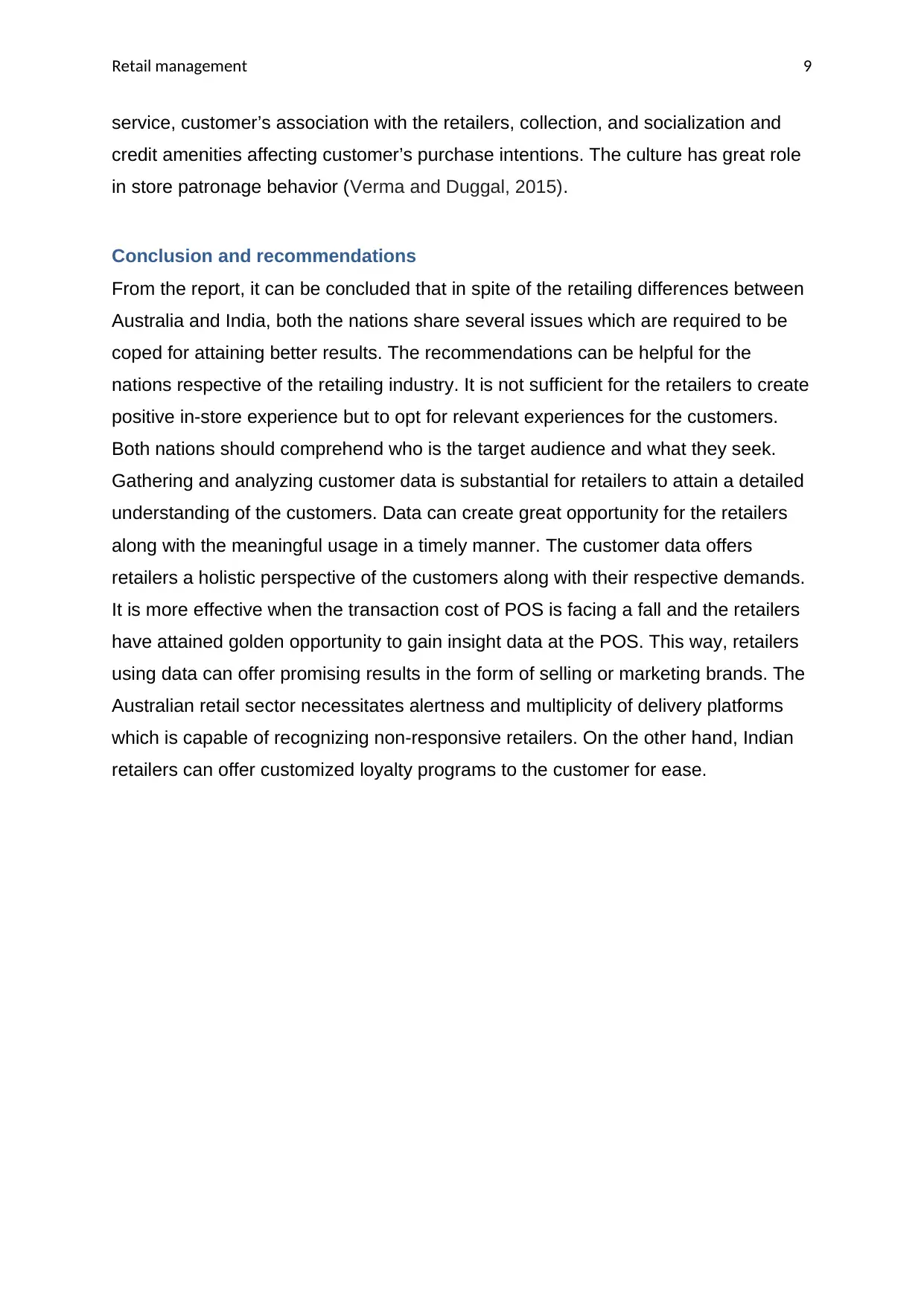
Retail management 9
service, customer’s association with the retailers, collection, and socialization and
credit amenities affecting customer’s purchase intentions. The culture has great role
in store patronage behavior (Verma and Duggal, 2015).
Conclusion and recommendations
From the report, it can be concluded that in spite of the retailing differences between
Australia and India, both the nations share several issues which are required to be
coped for attaining better results. The recommendations can be helpful for the
nations respective of the retailing industry. It is not sufficient for the retailers to create
positive in-store experience but to opt for relevant experiences for the customers.
Both nations should comprehend who is the target audience and what they seek.
Gathering and analyzing customer data is substantial for retailers to attain a detailed
understanding of the customers. Data can create great opportunity for the retailers
along with the meaningful usage in a timely manner. The customer data offers
retailers a holistic perspective of the customers along with their respective demands.
It is more effective when the transaction cost of POS is facing a fall and the retailers
have attained golden opportunity to gain insight data at the POS. This way, retailers
using data can offer promising results in the form of selling or marketing brands. The
Australian retail sector necessitates alertness and multiplicity of delivery platforms
which is capable of recognizing non-responsive retailers. On the other hand, Indian
retailers can offer customized loyalty programs to the customer for ease.
service, customer’s association with the retailers, collection, and socialization and
credit amenities affecting customer’s purchase intentions. The culture has great role
in store patronage behavior (Verma and Duggal, 2015).
Conclusion and recommendations
From the report, it can be concluded that in spite of the retailing differences between
Australia and India, both the nations share several issues which are required to be
coped for attaining better results. The recommendations can be helpful for the
nations respective of the retailing industry. It is not sufficient for the retailers to create
positive in-store experience but to opt for relevant experiences for the customers.
Both nations should comprehend who is the target audience and what they seek.
Gathering and analyzing customer data is substantial for retailers to attain a detailed
understanding of the customers. Data can create great opportunity for the retailers
along with the meaningful usage in a timely manner. The customer data offers
retailers a holistic perspective of the customers along with their respective demands.
It is more effective when the transaction cost of POS is facing a fall and the retailers
have attained golden opportunity to gain insight data at the POS. This way, retailers
using data can offer promising results in the form of selling or marketing brands. The
Australian retail sector necessitates alertness and multiplicity of delivery platforms
which is capable of recognizing non-responsive retailers. On the other hand, Indian
retailers can offer customized loyalty programs to the customer for ease.
Paraphrase This Document
Need a fresh take? Get an instant paraphrase of this document with our AI Paraphraser
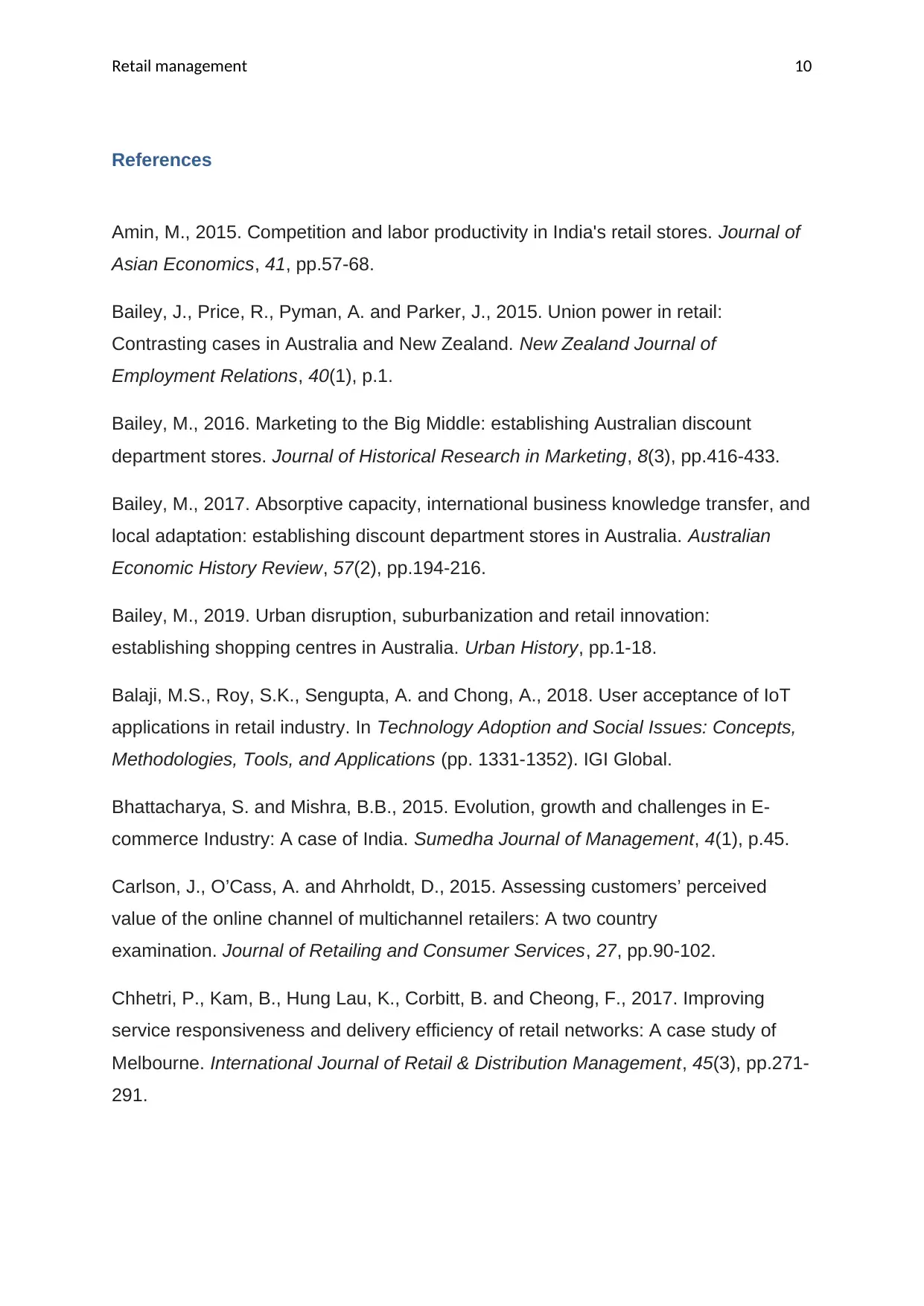
Retail management 10
References
Amin, M., 2015. Competition and labor productivity in India's retail stores. Journal of
Asian Economics, 41, pp.57-68.
Bailey, J., Price, R., Pyman, A. and Parker, J., 2015. Union power in retail:
Contrasting cases in Australia and New Zealand. New Zealand Journal of
Employment Relations, 40(1), p.1.
Bailey, M., 2016. Marketing to the Big Middle: establishing Australian discount
department stores. Journal of Historical Research in Marketing, 8(3), pp.416-433.
Bailey, M., 2017. Absorptive capacity, international business knowledge transfer, and
local adaptation: establishing discount department stores in Australia. Australian
Economic History Review, 57(2), pp.194-216.
Bailey, M., 2019. Urban disruption, suburbanization and retail innovation:
establishing shopping centres in Australia. Urban History, pp.1-18.
Balaji, M.S., Roy, S.K., Sengupta, A. and Chong, A., 2018. User acceptance of IoT
applications in retail industry. In Technology Adoption and Social Issues: Concepts,
Methodologies, Tools, and Applications (pp. 1331-1352). IGI Global.
Bhattacharya, S. and Mishra, B.B., 2015. Evolution, growth and challenges in E-
commerce Industry: A case of India. Sumedha Journal of Management, 4(1), p.45.
Carlson, J., O’Cass, A. and Ahrholdt, D., 2015. Assessing customers’ perceived
value of the online channel of multichannel retailers: A two country
examination. Journal of Retailing and Consumer Services, 27, pp.90-102.
Chhetri, P., Kam, B., Hung Lau, K., Corbitt, B. and Cheong, F., 2017. Improving
service responsiveness and delivery efficiency of retail networks: A case study of
Melbourne. International Journal of Retail & Distribution Management, 45(3), pp.271-
291.
References
Amin, M., 2015. Competition and labor productivity in India's retail stores. Journal of
Asian Economics, 41, pp.57-68.
Bailey, J., Price, R., Pyman, A. and Parker, J., 2015. Union power in retail:
Contrasting cases in Australia and New Zealand. New Zealand Journal of
Employment Relations, 40(1), p.1.
Bailey, M., 2016. Marketing to the Big Middle: establishing Australian discount
department stores. Journal of Historical Research in Marketing, 8(3), pp.416-433.
Bailey, M., 2017. Absorptive capacity, international business knowledge transfer, and
local adaptation: establishing discount department stores in Australia. Australian
Economic History Review, 57(2), pp.194-216.
Bailey, M., 2019. Urban disruption, suburbanization and retail innovation:
establishing shopping centres in Australia. Urban History, pp.1-18.
Balaji, M.S., Roy, S.K., Sengupta, A. and Chong, A., 2018. User acceptance of IoT
applications in retail industry. In Technology Adoption and Social Issues: Concepts,
Methodologies, Tools, and Applications (pp. 1331-1352). IGI Global.
Bhattacharya, S. and Mishra, B.B., 2015. Evolution, growth and challenges in E-
commerce Industry: A case of India. Sumedha Journal of Management, 4(1), p.45.
Carlson, J., O’Cass, A. and Ahrholdt, D., 2015. Assessing customers’ perceived
value of the online channel of multichannel retailers: A two country
examination. Journal of Retailing and Consumer Services, 27, pp.90-102.
Chhetri, P., Kam, B., Hung Lau, K., Corbitt, B. and Cheong, F., 2017. Improving
service responsiveness and delivery efficiency of retail networks: A case study of
Melbourne. International Journal of Retail & Distribution Management, 45(3), pp.271-
291.
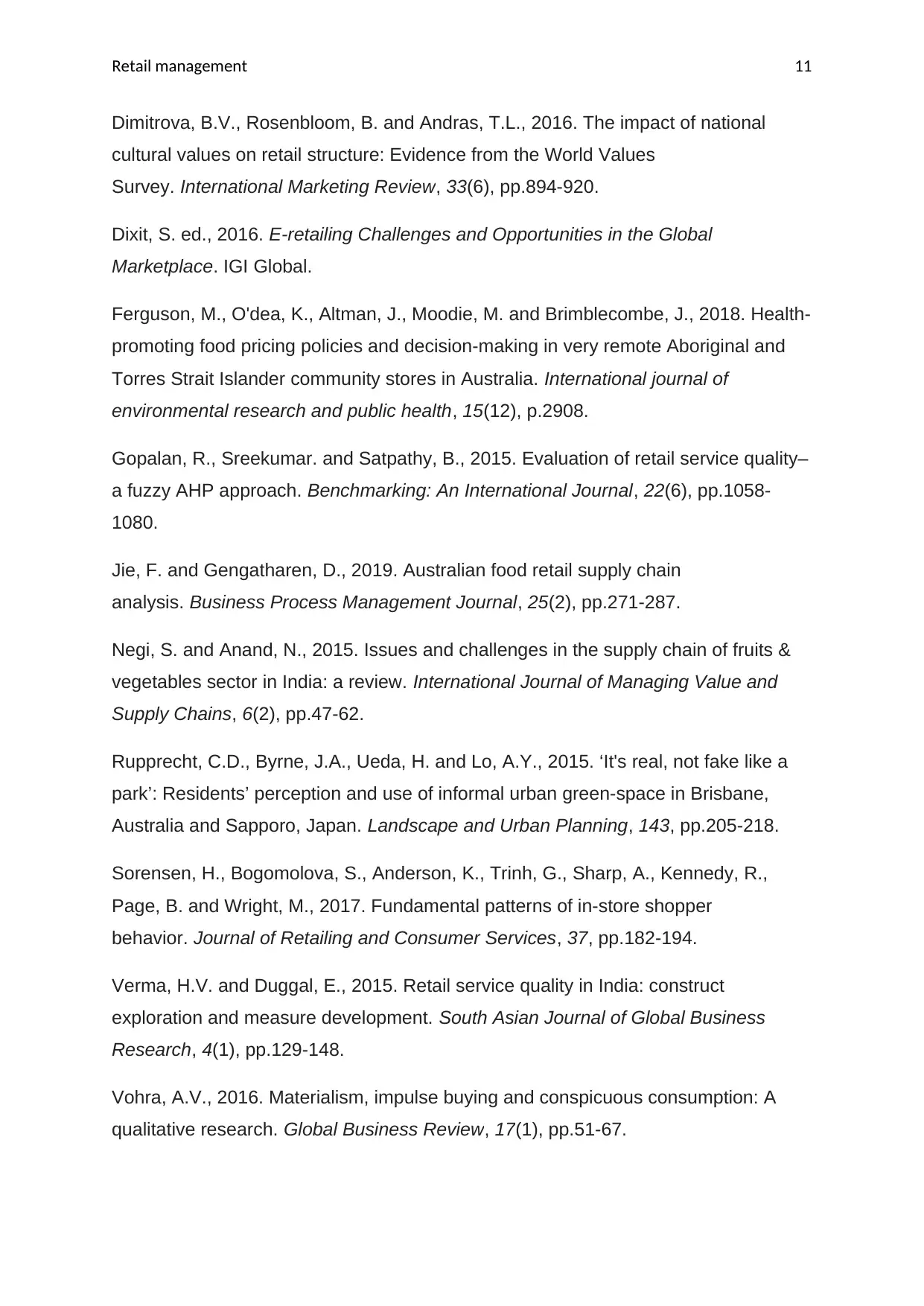
Retail management 11
Dimitrova, B.V., Rosenbloom, B. and Andras, T.L., 2016. The impact of national
cultural values on retail structure: Evidence from the World Values
Survey. International Marketing Review, 33(6), pp.894-920.
Dixit, S. ed., 2016. E-retailing Challenges and Opportunities in the Global
Marketplace. IGI Global.
Ferguson, M., O'dea, K., Altman, J., Moodie, M. and Brimblecombe, J., 2018. Health-
promoting food pricing policies and decision-making in very remote Aboriginal and
Torres Strait Islander community stores in Australia. International journal of
environmental research and public health, 15(12), p.2908.
Gopalan, R., Sreekumar. and Satpathy, B., 2015. Evaluation of retail service quality–
a fuzzy AHP approach. Benchmarking: An International Journal, 22(6), pp.1058-
1080.
Jie, F. and Gengatharen, D., 2019. Australian food retail supply chain
analysis. Business Process Management Journal, 25(2), pp.271-287.
Negi, S. and Anand, N., 2015. Issues and challenges in the supply chain of fruits &
vegetables sector in India: a review. International Journal of Managing Value and
Supply Chains, 6(2), pp.47-62.
Rupprecht, C.D., Byrne, J.A., Ueda, H. and Lo, A.Y., 2015. ‘It's real, not fake like a
park’: Residents’ perception and use of informal urban green-space in Brisbane,
Australia and Sapporo, Japan. Landscape and Urban Planning, 143, pp.205-218.
Sorensen, H., Bogomolova, S., Anderson, K., Trinh, G., Sharp, A., Kennedy, R.,
Page, B. and Wright, M., 2017. Fundamental patterns of in-store shopper
behavior. Journal of Retailing and Consumer Services, 37, pp.182-194.
Verma, H.V. and Duggal, E., 2015. Retail service quality in India: construct
exploration and measure development. South Asian Journal of Global Business
Research, 4(1), pp.129-148.
Vohra, A.V., 2016. Materialism, impulse buying and conspicuous consumption: A
qualitative research. Global Business Review, 17(1), pp.51-67.
Dimitrova, B.V., Rosenbloom, B. and Andras, T.L., 2016. The impact of national
cultural values on retail structure: Evidence from the World Values
Survey. International Marketing Review, 33(6), pp.894-920.
Dixit, S. ed., 2016. E-retailing Challenges and Opportunities in the Global
Marketplace. IGI Global.
Ferguson, M., O'dea, K., Altman, J., Moodie, M. and Brimblecombe, J., 2018. Health-
promoting food pricing policies and decision-making in very remote Aboriginal and
Torres Strait Islander community stores in Australia. International journal of
environmental research and public health, 15(12), p.2908.
Gopalan, R., Sreekumar. and Satpathy, B., 2015. Evaluation of retail service quality–
a fuzzy AHP approach. Benchmarking: An International Journal, 22(6), pp.1058-
1080.
Jie, F. and Gengatharen, D., 2019. Australian food retail supply chain
analysis. Business Process Management Journal, 25(2), pp.271-287.
Negi, S. and Anand, N., 2015. Issues and challenges in the supply chain of fruits &
vegetables sector in India: a review. International Journal of Managing Value and
Supply Chains, 6(2), pp.47-62.
Rupprecht, C.D., Byrne, J.A., Ueda, H. and Lo, A.Y., 2015. ‘It's real, not fake like a
park’: Residents’ perception and use of informal urban green-space in Brisbane,
Australia and Sapporo, Japan. Landscape and Urban Planning, 143, pp.205-218.
Sorensen, H., Bogomolova, S., Anderson, K., Trinh, G., Sharp, A., Kennedy, R.,
Page, B. and Wright, M., 2017. Fundamental patterns of in-store shopper
behavior. Journal of Retailing and Consumer Services, 37, pp.182-194.
Verma, H.V. and Duggal, E., 2015. Retail service quality in India: construct
exploration and measure development. South Asian Journal of Global Business
Research, 4(1), pp.129-148.
Vohra, A.V., 2016. Materialism, impulse buying and conspicuous consumption: A
qualitative research. Global Business Review, 17(1), pp.51-67.
⊘ This is a preview!⊘
Do you want full access?
Subscribe today to unlock all pages.

Trusted by 1+ million students worldwide
1 out of 13
Related Documents
Your All-in-One AI-Powered Toolkit for Academic Success.
+13062052269
info@desklib.com
Available 24*7 on WhatsApp / Email
![[object Object]](/_next/static/media/star-bottom.7253800d.svg)
Unlock your academic potential
Copyright © 2020–2025 A2Z Services. All Rights Reserved. Developed and managed by ZUCOL.




